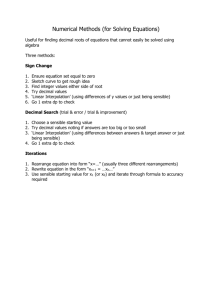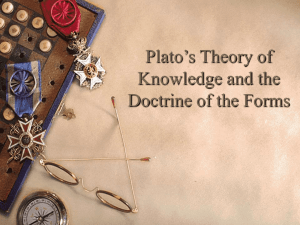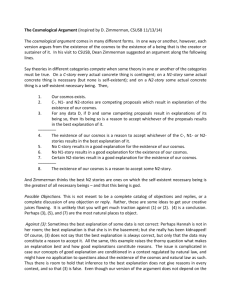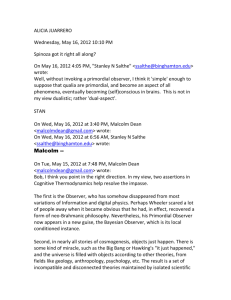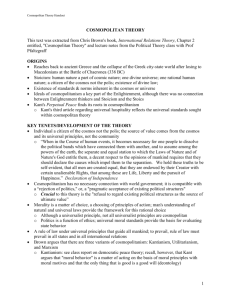Notes on Timaeus - Academic Csuohio
advertisement
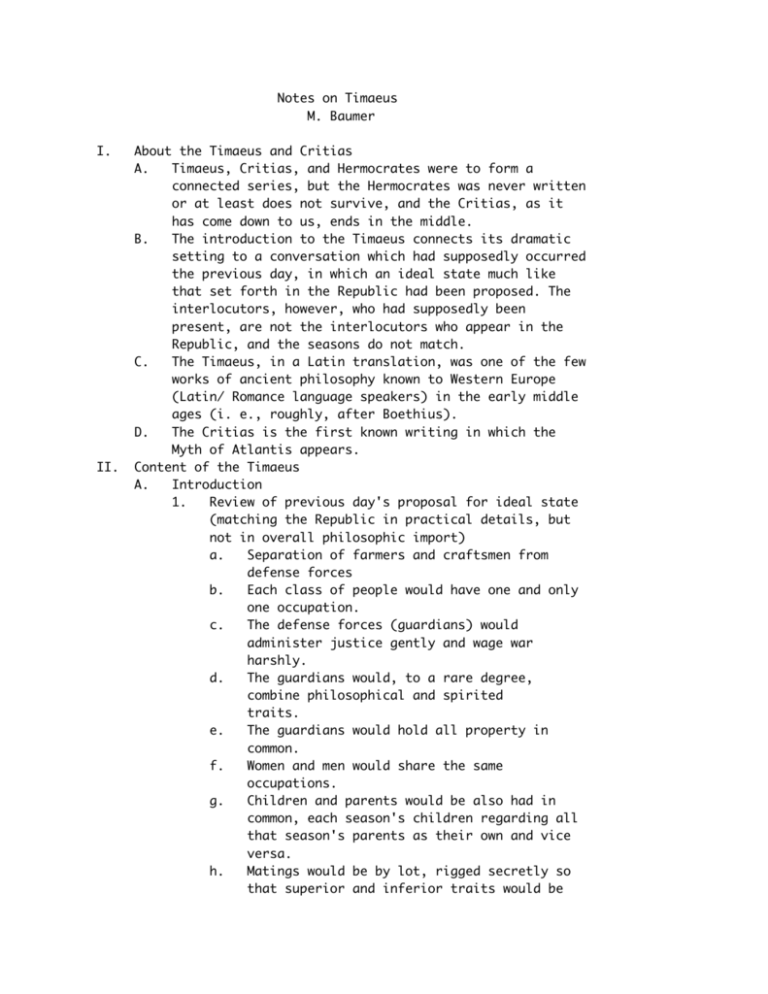
Notes on Timaeus M. Baumer I. II. About the Timaeus and Critias A. Timaeus, Critias, and Hermocrates were to form a connected series, but the Hermocrates was never written or at least does not survive, and the Critias, as it has come down to us, ends in the middle. B. The introduction to the Timaeus connects its dramatic setting to a conversation which had supposedly occurred the previous day, in which an ideal state much like that set forth in the Republic had been proposed. The interlocutors, however, who had supposedly been present, are not the interlocutors who appear in the Republic, and the seasons do not match. C. The Timaeus, in a Latin translation, was one of the few works of ancient philosophy known to Western Europe (Latin/ Romance language speakers) in the early middle ages (i. e., roughly, after Boethius). D. The Critias is the first known writing in which the Myth of Atlantis appears. Content of the Timaeus A. Introduction 1. Review of previous day's proposal for ideal state (matching the Republic in practical details, but not in overall philosophic import) a. Separation of farmers and craftsmen from defense forces b. Each class of people would have one and only one occupation. c. The defense forces (guardians) would administer justice gently and wage war harshly. d. The guardians would, to a rare degree, combine philosophical and spirited traits. e. The guardians would hold all property in common. f. Women and men would share the same occupations. g. Children and parents would be also had in common, each season's children regarding all that season's parents as their own and vice versa. h. Matings would be by lot, rigged secretly so that superior and inferior traits would be B. reinforced. i. Offspring of the inferior matings would be raised within the craftsman class. j. There would be periodic reshuffling of the classes to make them continue to conform with ability. 2. Socrates would like to imagine such a society in action -- especially at war. 3. Others have prepared a three-part entertainment for Socrates. It is in part based on a story in Critias' family which Solon once heard from an Egyptian priest. a. Outline of story (1) There are periodic destructions of the earth which wipe out cultural memories, but such memories have been preserved longer in Egypt than in Greece, because Egypt is less vulnerable to such destructions. (2) A number of cycles back (9000 years) Athens was the supreme nation of the Mediterranean basin. (3) An island nation, Atlantis, which was located in the Ocean beyond the Pillars of Heracles (the Straits of Gibraltar) and occupied an area greater than that of Libya (North Africa) and Asia (Asia Minor) combined, ruled the Mediterranean basin as far east as Italy. (4) The Atlanteans attempted to conquer the entire Mediterranean basin, but were repulsed and driven back into the sea wholly by the Athenians. b. This ancient Athens is to be Socrates' ideal state in action. c. The story of the great war between Athens and Atlantis is to be preceded by an account of the creation and nature of the cosmos, the gods, and humans. Main body of Timaeus 1. The elements of creation: the creator, the sensible cosmos, and the invisible cosmos a. We must distinguish between that which always becomes and never is (the changing) and that which always is and never becomes (the eternal) [these are not by any means the only 2. 3. 4. possibilities -- why they are the only ones listed here is unstated]. b. That which is is the object of knowledge (reflection of Parmenides' philosophy). c. That which becomes is the object of opinion. d. (The distinction in the previous two points may account for there being no middle possibility.) e. What becomes must have a maker. f. [The maker must look to a pattern.] g. Whenever the pattern to which the maker looks is eternal, the creation is good; but when the pattern is changing, the creation is bad. h. The sensible cosmos, since it changes, has come into being. i. Thus the sensible cosmos had a creator. j. Since the cosmos is the most beautiful of all sensible things, it was created from an eternal pattern. k. Of the eternal there is knowledge -- that is, unchanging (invariantly true) discourse, while of the changing there is at best opinion (discourse whose truth or falsity changes as the things themselves change). l. Therefore, my account of the sensible cosmos will be at best approximate. The reason for creation. a. Since God is good, he wanted everything to be as good as possible, but he found the sensible cosmos in a state of disorder. (Here it is implied that the eternal cosmos is the creator himself.) b. Therefore he created the universe a living being, a mind in a soul in a body. The eternal cosmos a. The eternal cosmos is therefore an intelligible living being, containing intelligibly all intelligibles whose copies inhabit the sensible living being which is the sensible cosmos. b. There is therefore but one sensible cosmos, since it must imitate the uniqueness of the intelligible cosmos as perfectly as possible. The elements a. What comes to be is corporeal -- therefore visible and tangible -- therefore containing b. c. d. e. f. 5. fire and earth Since all bodies are three-dimensional, and between two cubes there are two mean proportionals, there must be two "substances" between fire and earth. Because the sensible cosmos was to be complete and perfect, the creator used the totality of each element, so that nothing was left over. Thus there is nothing material which is not part of the cosmos. Since the cosmos needs to interact physically with nothing outside it, and since the sphere is the most perfect figure, the sensible cosmos has no external organs and is perfectly spherical. The creator diffused soul throughout the whole. Soul a. Soul, being dominant over body, was actually created first. b. Soul is intermediate between the intelligible and the sensible. c. (Sensible = divisible.) d. [In the Sophist, the principal Ideas are said to be Being, Sameness, Difference, Motion, and Rest.] e. Recipe for Soul: (1) First (a) Mix intelligible and sensible being, (b) Mix intelligible and sensible sameness, (c) Mix intelligible and sensible difference, (2) Then mix the results of the first three mixtures. f. Division of soul (thought of as a strip): (1) Into parts according to the Pythagorean musical scale (2) Then lengthwise in two parts: (a) One of which becomes the celestial equator (b) The second of which becomes another great circle of the celestial sphere known as the "ecliptic" (the g. h. i. j. apparent path of the Sun among the stars) (3) Then the ecliptic strip is divided into seven parts and apportioned among the seven "planets" (the Moon, the Sun, Venus, Mercury, Mars, Jupiter, and Saturn) Motions of the heavenly circles (1) The motion along the celestial equator he called the Same (since it is this motion that apparently produces day and night and it otherwise invariant) (2) The motion along the ecliptic he called the Different (since it produces the seasons, and through the seasons apparently all other earthly changes). (3) The World Soul (the Soul-stuff, distributed in the celestial circles) knows the sensible cosmos through the circle of the different (producing opinion) and knows the Intelligible Living Creature through the circle of the Same (producing knowledge). Time (1) In order to make the copy as much like the original as possible, the Creator created time as the moving image of eternity, and created the planets as measures of time. The Perfect Year (1) The perfect year is the period in which the planets all return to the same initial total position. Sensible Living Creatures Which Are Parts of the Sensible Cosmos (1) Gods (a) First, "fixed" stars, each of which has two motions, rotating in place and revolving with the celestial sphere. (b) Second, the Earth, our Mother. (c) Third, the other gods, as is told in the Hesiodic myths. (2) Mortal Living Creatures (aerial, aquatic, terrestrial) (a) The Creator assembled the created 6. gods and told them i) They were immortal by his will, although created ii) They were to create the bodies of mortal animals. (b) Then the Creator created the souls of mortal animals: i) Of the remaining soul-stuff he made a soul for each star. ii) He showed each soul the nature of the universe and the laws of destiny, which are: a) Each first incarnation would be as a male, second as a female, third as a lower animal. b) Each must master pleasure and pain. c) Only through doing so can one escape rebirth and dwell in one's proper star. (c) Then the Creator sowed the souls of mortal animals in their vehicles (bodies) on the Moon, other planets, and Earth. (d) Meanwhile, the created gods made these vehicles with little rivets, too tiny to see. Other important points a. Although there are material causes, represented by chance or necessity, they are subordinate to the intelligent cause of all things. b. Necessity is represented in the sensible cosmos by the Receptacle or Nurse (sometimes Space). [This appears to be similar to Aristotle's primary matter.] c. The elements (earth, air, fire, and water) are really "qualities". d. A theory of the elements: they correspond to four of the five regular solids possible in Euclidean space: (1) Fire: Tetrahedron (2) Air: Octahedron (3) Water: Icosahedron (4) (5) e. f. g. Earth: Cube (The cosmos as a whole corresponds to the dodecahedron.) Since they are composed of like (in shape) triangles, fire, air, and water are transformable into one another. Earth, however, can only be dissolved in the others. Since each of the two types of triangle hypothesized (90-45-45 degrees) and (90-60-30 degrees) can be of any size, there are many kinds of earth, water, air, fire. (Thus in the Timaeus these are closer to what we would call "states" than to substances, with fire corresponding to light.)
